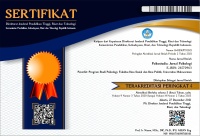Digital Parenting as A Predictor of Second Language Acquisition in Children
Abstract
Akses teknologi dan paparan media digital memungkinkan anak-anak mengembangkan keterampilan menggunakan bahasa kedua atau bahasa asing. Di sisi lain, sebagai bagian dari kehidupan anak sehari-hari, orangtua membutuhkan pengasuhan digital untuk memastikan kebermanfaatan teknologi dan media digital bagi perkembangan anak. Penelitian ini bertujuan untuk menguji secara empiris peran pengasuhan digital dalam menentukan pemerolehan bahasa kedua pada anak-anak. Sejumlah 175 orangtua yang memiliki anak berusia 4-9 tahun terlibat dalam penelitian ini. Pengambilan sampel dilakukan secara convenience dengan menyebarkan instrumen penelitian pada komunitas orangtua siswa TK dan SD. Analisis statistik regresi linier sederhana menunjukkan taraf signifikansi 0,000 (p<0,05) yang berarti bahwa ada pengaruh yang signifikan antara pemerolehan bahasa kedua pada anak-anak dan pengasuhan digital. Orangtua berperan penting dalam menerapkan pengasuhan yang mendukung perkembangan bahasa anak sekaligus memperhatikan penggunaan teknologi dan media digital yang proporsional.
Keywords
Full Text:
FULL TEXTReferences
Adi, A., Widi A, R., Araminta P, O., & Sumarlam. (2018). Peranan Pola Pengasuhan Terhadap Pemerolehan Bahasa Pada Anak : Sebuah Kajian Psikolinguistik. LITERASI, Jurnal Ilmiah Pend. Bahasa, Sastra Indonesia Dan Daerah, 8(2), 75–83.
Akkaya, S., Tan, Z., Kapidere, M., & Şahin, S. (2021). Investigation of the Relationship between Parents’ Awareness of Digital Parenting and the Effects of Digital Games on Their Children. İnönü Üniversitesi Eğitim Fakültesi Dergisi, 22(1), 889–917. https://doi.org/10.17679/inuefd.905569
Alia, T., & Irwansyah. (2018). Pendampingan Orang Tua pada Anak Usia Dini dalam Penggunaan Teknologi Digital. A Journal of Language, Literature, Culture and Education, 14(1), 65–78. http://dx.doi.org/10.19166/pji.v14i1.639
Almeida, P. A., & Costa, P. D. (2014). Foreign Language Acquisition: The Role of Subtitling. Procedia - Social and Behavioral Sciences, 141, 1234–1238. https://doi.org/10.1016/j.sbspro.2014.05.212
Alobaid, A. O. (2023). The Effects of Task-Induced Involvement Load on Incidental Second Language Vocabulary Acquisition through Reading. Department of English Language and Literature: School of Literature and Languages, The University of Reading, United Kindom (M.A.Thesis). Retrieved from Arab World English Journal (ID Number: 288) January, 2023:1- 84. DOI: https://dx.doi.org/10.24093/awej/th.288
Baiti, N. (2020). Pola Asuh dan Komunikasi Orang Tua Terhadap Perkembangan Bahasa Anak. PAUD Lectura: Jurnal Pendidikan Anak Usia Dini, 4(01), 42–50. https://doi.org/10.31849/paud-lectura.v4i01.4959
Benedetto, L., & Ingrassia, M. (2021). Digital Parenting: Raising and Protecting Children in Media World. Parenting - Studies by an Ecocultural and Transactional Perspective. https://doi.org/10.5772/intechopen.92579
Brushe, M. E., Lynch, J. W., Melhuish, E., Reilly, S., Mittinty, M. N., & Brinkman, S. A. (2023). Objectively measured infant and toddler screen time: Findings from a prospective study. SSM - Population Health, 22(April), 101395. https://doi.org/10.1016/j.ssmph.2023.101395
Cahyani, P. A. H. I. I. M. S., & Dewantara, I. P. M. (2022). Pengaruh Teknologi Terhadap Pemerolehan Dan Perkembangan Semantik Serta Sintaksis Kanak-Kanak Usia 2-3 Tahun. Jurnal Pendidikan Dan Pembelajaran Bahasa Indonesia, 11(1), 24–32. https://doi.org/10.23887/jurnal_bahasa.v11i1.964
Cao, S., Dong, C., & Li, H. (2022). Digital parenting during the COVID-19 lockdowns: how Chinese parents viewed and mediated young children’s digital use. Early Child Development and Care, 192(15), 2401–2416. https://doi.org/10.1080/03004430.2021.2016732
Çetin, Y., Ömer, S., & Hüseyin, K. (2012). Sosyal Ortamlardaki Oyunlardan Dolaylı Yoldan Yabancı Dile Ait Kelime Edinimi. Sosyal Ortamlardaki Oyunlardan Dolaylı Yoldan Yabancı Dile Ait Kelime Edinimi, (9)(2). Retrieved from https://www.j-humansciences.com/ojs/index.php/IJHS/article/view/2223
Chung, S., Zhou, Q., Anicama, C., Rivera, C., & Uchikoshi, Y. (2019). Language Proficiency, Parenting Styles, and Socioemotional Adjustment of Young Dual Language Learners. Journal of Cross-Cultural Psychology, 50(7), 896–914. https://doi.org/10.1177/0022022119867394
d’Ydewalle, Gery and Poel, M. Van de. (1999). Incidental foreign-language acquisition by children watching subtitled television programs. Journal of Psycholinguistic Research, 13(4), 81–87. https://doi.org/10.1075/btl.34.30van
Darling, N. and L. S. (2017). Parenting style as context: An integrative model, in Laursen, B. & Zukauskiene, R. (eds.), Interpersonal development, pp. 161–170, Routledge. https://doi.org/10.4324/9781351153683
Daugherty, Lindsay, Rafiq Dossani, E.-E. J. and C. W. (2016). Improving Family Engagement in Early Childhood Education Through Technology (pp. 1–8). RAND Corporation. http://www.jstor.org/stable/10.7249/j.ctt14bs2fx.1
Denhovska, N., Serratrice, L., & Payne, J. (2016). Acquisition of Second Language Grammar Under Incidental Learning Conditions: The Role of Frequency and Working Memory. Language Learning, 66(1), 159–190. https://doi.org/10.1111/lang.12142
Dharmowijono, W. W. (2009). P s ik o li n g u i st ik : T e or i K e m a mpu a n B e r baha s a da n P e m e ro leha n B aha s a A n ak B u k u T ek s.
Fidan, N. K. (2023). Examining the relationship between parents' digital parenting self-efficacy and digital parenting attitudes. Education and Information Technologies, 1–16. Advance online publication. https://doi.org/10.1007/s10639-023-11841-2
Fitri, W. E. (2023). Pengaruh Tontonan Platform Youtube Dalam Pemerolehan Bahasa Anak. Jurnal Pendidikan, Bahasa Dan Budaya, 2(2), 148–154. https://doi.org/10.55606/jpbb.v2i2.1471
Gass, Susan M. and Selinker, L. (2008). Second language acquisition. In A Companion to Chomsky. https://doi.org/10.1002/9781119598732.ch14
Gath, M., McNeill, B., & Gillon, G. (2023). Preschoolers’ screen time and reduced opportunities for quality interaction: Associations with language development and parent-child closeness. Current Research in Behavioral Sciences, 5(June 2022), 100140. https://doi.org/10.1016/j.crbeha.2023.100140
Huang, G., Li, X., Chen, W., & Straubhaar, J. D. (2018). Fall-Behind Parents? The Influential Factors on Digital Parenting Self-Efficacy in Disadvantaged Communities. American Behavioral Scientist, 62(9), 1186–1206. https://doi.org/10.1177/0002764218773820
Hulstijn, J. H. (2012). Incidental Learning in Second Language Acquisition. The Encyclopedia of Applied Linguistics. https://doi.org/10.1002/9781405198431.wbeal0530
Ina, L. (2014). Incidental foreign-language acquisition by children watching subtitled television programs. Turkish Online Journal of Educational Technology, 13(4), 81–87. https://doi.org/10.1075/btl.34.30van
Iruka, I. U., De Marco, A., & Garrett-Peters, P. (2018). Profiles of academic/socioemotional competence: Associations with parenting, home, child care, and neighborhood. Journal of Applied Developmental Psychology, 54(October 2017), 1–11. https://doi.org/10.1016/j.appdev.2017.11.002
Jahrani, A., & Listia, R. (2023). The Impact of Exposure on Second Language Acquisition. IDEAS: Journal on English Language Teaching and Learning, Linguistics and Literature, 11(1), 416–424. https://doi.org/10.24256/ideas.v11i1.3581
Khatami, E., Ameri, S., & Navidinia, H. (2023). Watching Videos and Foreign Language Acquisition:Formulaic Sequences in Focus. Media and Intercultural Communication: A Multidisciplinary Journal, 1(2), 40–60. https://doi.org/10.22034/MIC. 2023.173443
Khodadady, E., & Younesi, M. (2017). Factors underlying characteristics of acquisition of English language in EFL classrooms. Journal of English Language Teaching and Learning, 19(19), 73–90.
Konok, V., Bunford, N., & Miklósi, Á. (2020). Associations between child mobile use and digital parenting style in Hungarian families. Journal of Children and Media, 14(1), 91–109. https://doi.org/10.1080/17482798.2019.1684332
Kuppens, A. H. (2010). Incidental foreign language acquisition from media exposure. Learning, Media and Technology, 35(1), 65–85. https://doi.org/10.1080/17439880903561876
Laible, D. J., Carlo, G., & Raffaelli, M. (2000). The differential relations of parent and peer attachment to adolescent adjustment. Journal of Youth and Adolescence, 29(1), 45–59. https://doi.org/10.1023/A:1005169004882
Legner, L. (2022). Kids’ screen time: How much is too much? . OSF HealthCare, Cdc, 8–10. https://www.osfhealthcare.org/blog/kids-screen-time-how-much-is-too-much/
Lei, S. (2023). The Role of Videos’ Subtitles in Second Language Acquisition. Journal of Education, Humanities and Social Sciences, 13, 12–20. https://doi.org/10.54097/ehss.v13i.7848
Lemish, D., Elias, N., & Floegel, D. (2020). “Look at me!” Parental use of mobile phones at the playground. Mobile Media and Communication, 8(2), 170–187. https://doi.org/10.1177/2050157919846916
Lunkenheimer, E., Hamby, C. M., Lobo, F. M., Cole, P. M., & Olson, S. L. (2020). The role of dynamic, dyadic parent-child processes in parental socialization of emotion. Developmental Psychology, 56(3), 566–577. https://doi.org/10.1037/dev0000808
Machmud, K. (2018). The Smartphone Use in Indonesian Schools: The High School Students’ Perspectives. Journal of Arts and Humanities, 7(3), 33. https://doi.org/10.18533/journal.v7i3.1354
Madigan, S., McArthur, B. A., Anhorn, C., Eirich, R., & Christakis, D. A. (2020). Associations between Screen Use and Child Language Skills: A Systematic Review and Meta-analysis. JAMA Pediatrics, 174(7), 665–675. https://doi.org/10.1001/jamapediatrics.2020.0327
MANAP, A., & DURMUŞ, E. (2020). DİJİTALEbeveynli̇k FarkindaliÖlçeği̇nGeli̇şti̇ri̇lmesi̇. İnönü Üniversitesi Eğitim Fakültesi Dergisi, 21(2), 978–993. https://doi.org/10.17679/inuefd.711101
Modecki, K. L., Goldberg, R. E., Wisniewski, P., & Orben, A. (2022). What Is Digital Parenting? A Systematic Review of Past Measurement and Blueprint for the Future. Perspectives on Psychological Science, 17(6), 1673–1691. https://doi.org/10.1177/17456916211072458
Morris, A. J., Filippetti, M. L., & Rigato, S. (2022). The impact of parents’ smartphone use on language development in young children. Child Development Perspectives, 16(2), 103–109. https://doi.org/10.1111/cdep.12449
Mustakim, M., Farhan, H., Lilawati, A., Ladamay, O. M. M. A., Musayyachah, M., & Pratiwi, R. S. (2021). Pengasuhan orang tua anak usia dini di era disrupsi. Jurnal Inovasi Hasil Pengabdian Masyarakat (JIPEMAS), 4(1), 19. https://doi.org/10.33474/jipemas.v4i1.7236
Nayci, Ö. (2021). Examination of Digital Parenting Awareness of the Primary School Students’ Parents During the COVID-19 Pandemic. Pegem Egitim ve Ogretim Dergisi, 11(2), 58–71. https://doi.org/10.14527/pegegog.2021.00
Nylund, A., Korpilahti, P., Kaljonen, A., & Rautakoski, P. (2023). Associations of paternal factors and child’s sex with early vocabulary development – The STEPS study. First Language, 43(2), 178–199. https://doi.org/10.1177/01427237221133623
Oden, M. S. (2019). Parenting styles and children’ s usage of the internet in the digital age. 1–127. https://scholarworks.waldenu.edu/dissertations
Parish-Morris, J., Mahajan, N., Hirsh-Pasek, K., Golinkoff, R. M., & Collins, M. F. (2013). Once upon a time: Parent-child dialogue and storybook reading in the electronic era. Mind, Brain, and Education, 7(3), 200–211. https://doi.org/10.1111/mbe.12028
Pearson, B. Z. (2012). Children with two languages. In The Cambridge Handbook of Child Language (pp. 355–376). https://doi.org/10.1017/cbo9780511576164.020
Power, T. G. (2013). Parenting dimensions and styles: A brief history and recommendations for future research. Childhood Obesity, 9(SUPPL.1), 14–21. https://doi.org/10.1089/chi.2013.0034
Pratiwi, H., Hasanah, N. I., Purnama, S., Ulfah, M., & Saripudin, A. (2022). Adaptation to digital parenting in a pandemic: A case study of parents within higher education. South African Journal of Childhood Education, 12(1), 1–12. https://doi.org/10.4102/sajce.v12i1.1166
Prensky, M. (2001). Digital Natives, Digital Immigrants. Archives of Design Research, 33(1), 17–35. https://doi.org/10.15187/adr.2020.02.33.1.17
Purnama, S. (2018). Al Hikmah Proceedings on Islamic Early Childhood Education: Pengasuhan Digital untuk Anak Generasi Alpha Pengasuhan Digital untuk Anak Generasi Alpha. Al Hikmah Proceedings on Islamic Early Childhood Education, 1, 439–502. https://www.academia.edu/download/57365843/Pengasuhan_Digital_48_Sigit_Purnama_493-502.pdf%0Ahttp://conference.staialhikmahtuban.ac.id/index.php/ah-piece
Reynolds, B. L., Xie, X. (Serina), & Pham, Q. H. P. (2022). Incidental vocabulary acquisition from listening to English teacher education lectures: A case study from Macau higher education. Frontiers in Psychology, 13(September), 1–18. https://doi.org/10.3389/fpsyg.2022.993445
Siregar, F. S. (2017). Parents ’ role in fostering young children’s. Disampaikan Dalam The 1st International Conference on Language, Literature and Teaching, 408–412. https://publikasiilmiah.ums.ac.id/bitstream/handle/11617/9229/E51.pdf?sequence=1
Soyoof, A., Reynolds, B. L., Neumann, M., Scull, J., Tour, E., & Mclay, K. (2023). Lay Description What is already known about this topic. 40(1), 1–6. https://doi.org/10.1111/jcal.12866
Sufa, A. F., & Dzulfikri, D. (2023). Exploring a Toddler’s Foreign Language Development through Watching English Videos on YouTube. Jurnal Obsesi : Jurnal Pendidikan Anak Usia Dini, 7(2), 1723–1732. https://doi.org/10.31004/obsesi.v7i2.4072
Syaprizal, M. P. (2019). Proses Pemerolehan Bahasa Pada Anak. Jurnal AL-HIKMAH, 1(2), 75–86. https://doi.org/10.36378/al-hikmah.v1i2.213
Tamis-Lemonda, Catherine S, ., & EILEEN T., R. (2008). Parents’ role in fostering young children’s learning and language development. Encyclopedia on Early Childhood Development, 1–9. http://www.child-encyclopedia.com/pages/pdf/parenting_skills.pdf#page=35
Tosun, N., & Mihci, C. (2020). An examination of digital parenting behavior in parents with preschool children in the context of lifelong learning. Sustainability (Switzerland), 12(18). https://doi.org/10.3390/su12187654
Wulandari, S. M. (2016). Hubungan Pola Bermain Game Online Dengan Daya Ingat Pada Remaja (Usia 12-14 Tahun) Di Smp Brawijaya Smart School Malang. Sarjana thesis, Universitas Brawijaya. 2016. http://repository.ub.ac.id/id/eprint/126120
Xu, H., Wen, L. M., & Rissel, C. (2015). Associations of parental influences with physical activity and screen time among young children: A systematic review. Journal of Obesity, 2015. https://doi.org/10.1155/2015/546925
Yaman, F., Dönmez, O., Akbulut, Y., Yurdakul, I. K., Çoklar, A. N., & Güyer, T. (2019). Exploration of parents’ digital parenting efficacy through several demographic variables. Egitim ve Bilim, 44(199), 149–172. https://doi.org/10.15390/EB.2019.7897
Yaşaroğlu, C., & Sönmez, D. (2022). Evaluating the digital parenting levels of parents of primary school students during the pandemic based on different variables. Research on Education and Media, 14(2), 97–107. https://doi.org/10.2478/rem-2022-0027
Yatziv, T., Simchon, A., Manco, N., Gilead, M., & Rutherford, H. J. V. (2022). Parental Mentalizing During a Pandemic: Use of Mental-State Language on Parenting Social Media Before and During the COVID-19 Pandemic. Clinical Psychological Science, 10(6), 1129–1150. https://doi.org/10.1177/21677026211062612
Younesi, M. (2020). Designing and Validating an English Language Acquisition Scale and Examining its Relationship with English Achievement and Teacher Effectiveness in EFL Classes. Applied Linguistics Research Journal, 4(5), 137–153. https://doi.org/10.14744/alrj.2020.39358
Yusuf, M., Witro, D., Diana, R., Santosa, T. A., Alfikri, A. ‘Alwiyah, & Jalwis, J. (2020). Digital Parenting to Children Using The Internet. Pedagogik Journal of Islamic Elementary School, 3(1), 1–14. https://doi.org/10.24256/pijies.v3i1.1277
Zaini, M., & Soenarto, S. (2019). Persepsi Orangtua Terhadap Hadirnya Era Teknologi Digital di Kalangan Anak Usia Dini. Jurnal Obsesi : Jurnal Pendidikan Anak Usia Dini, 3(1), 254. https://doi.org/10.31004/obsesi.v3i1.127
Zhang, Z. (2022). Review of the Incidental Second Language Acquisition of Subtitles in Video Products. Proceedings of the 2022 3rd International Conference on Language, Art and Cultural Exchange(ICLACE 2022), 673(Iclace), 98–102. https://doi.org/10.2991/assehr.k.220706.021
DOI: http://dx.doi.org/10.30872/psikostudia.v14i2.17274
Refbacks
- There are currently no refbacks.
Copyright (c) 2025 Lucky Ade Sessiani, Alya Lupita Dewanti, Anisatun Niswah

This work is licensed under a Creative Commons Attribution-ShareAlike 4.0 International License.
Psikostudia: Jurnal Psikologi is indexed by :
PSIKOSTUDIA: Jurnal Psikologi Published by Faculty of Social and Political Siences, University of Mulawarman, Samarinda, East Kalimantan and This work is licensed under a Creative Commons Attribution-ShareAlike 4.0 International License.
_________________________________________
PSIKOSTUDIA: Jurnal Psikologi
Department of Psychology
Faculty of Social and Political Siences, University of Mulawarman
Jl. Muara Muntai Kampus Gn. Kelua Samarinda 75411
Phone: +62 813 35350368
E-Mail: psikostudia@fisip.unmul.ac.id




















